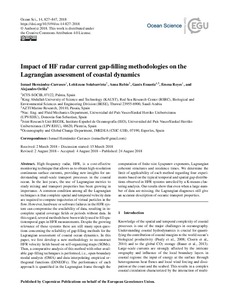| dc.contributor.author | Hernández-Carrasco, Ismael | |
| dc.contributor.author | Solabarrieta, Lohitzune | |
| dc.contributor.author | Rubio, Anna | |
| dc.contributor.author | Esnaola, Ganix | |
| dc.contributor.author | Reyes, Emma | |
| dc.contributor.author | Orfila, Alejandro | |
| dc.date.accessioned | 2020-11-19T21:27:03Z | |
| dc.date.available | 2020-11-19T21:27:03Z | |
| dc.date.issued | 2018 | |
| dc.identifier.citation | Hernández-Carrasco, I. Solabarrieta. L.; Rubio, A. et al (2018) Impact of HF radar current gap-filling methodologies on the
Lagrangian assessment of coastal dynamics. Ocean Science, 14, pp.827-847. DOI: https://doi.org/10.5194/os-14-827-2018 | en_US |
| dc.identifier.uri | http://hdl.handle.net/11329/1450 | |
| dc.identifier.uri | http://dx.doi.org/10.25607/OBP-953 | |
| dc.description.abstract | High-frequency radar, HFR, is a cost-effective
monitoring technique that allows us to obtain high-resolution
continuous surface currents, providing new insights for understanding
small-scale transport processes in the coastal
ocean. In the last years, the use of Lagrangian metrics to
study mixing and transport properties has been growing in
importance. A common condition among all the Lagrangian
techniques is that complete spatial and temporal velocity data
are required to compute trajectories of virtual particles in the
flow. However, hardware or software failures in the HFR system
can compromise the availability of data, resulting in incomplete
spatial coverage fields or periods without data. In
this regard, several methods have been widely used to fill spatiotemporal
gaps in HFR measurements. Despite the growing
relevance of these systems there are still many open questions
concerning the reliability of gap-filling methods for the
Lagrangian assessment of coastal ocean dynamics. In this
paper, we first develop a new methodology to reconstruct
HFR velocity fields based on self-organizing maps (SOMs).
Then, a comparative analysis of this method with other available
gap-filling techniques is performed, i.e., open-boundary
modal analysis (OMA) and data interpolating empirical orthogonal
functions (DINEOFs). The performance of each
approach is quantified in the Lagrangian frame through the computation of finite-size Lyapunov exponents, Lagrangian
coherent structures and residence times. We determine the
limit of applicability of each method regarding four experiments
based on the typical temporal and spatial gap distributions
observed in HFR systems unveiled by a K-means clustering
analysis. Our results show that even when a large number
of data are missing, the Lagrangian diagnoses still give
an accurate description of oceanic transport properties. | en_US |
| dc.language.iso | en | en_US |
| dc.rights | Attribution 4.0 International | * |
| dc.rights.uri | http://creativecommons.org/licenses/by/4.0/ | * |
| dc.subject.other | HF Radar | en_US |
| dc.subject.other | Lagrangian assessement | en_US |
| dc.subject.other | Gap filling techniques | en_US |
| dc.title | Impact of HF radar current gap-filling methodologies on the Lagrangian assessment of coastal dynamics. | en_US |
| dc.type | Journal Contribution | en_US |
| dc.description.refereed | Refereed | en_US |
| dc.format.pagerange | pp.827-847 | en_US |
| dc.identifier.doi | https://doi.org/10.5194/os-14-827-2018 | |
| dc.subject.parameterDiscipline | Parameter Discipline::Physical oceanography::Currents | en_US |
| dc.bibliographicCitation.title | Ocean Science | en_US |
| dc.bibliographicCitation.volume | 14 | en_US |
| dc.description.sdg | 14 | en_US |
| dc.description.eov | Surface currents | en_US |
| dc.description.maturitylevel | TRL 8 Actual system completed and "mission qualified" through test and demonstration in an operational environment (ground or space) | en_US |
| dc.description.bptype | Manual (incl. handbook, guide, cookbook etc) | en_US |
| obps.contact.contactname | Ismael Hernández-Carrasco | |
| obps.contact.contactemail | ismaelhe@gmail.com | |
| obps.resourceurl.publisher | https://os.copernicus.org/articles/14/827/2018/ | en_US |
 Repository of community practices in Ocean Research, Applications and Data/Information Management
Repository of community practices in Ocean Research, Applications and Data/Information Management

